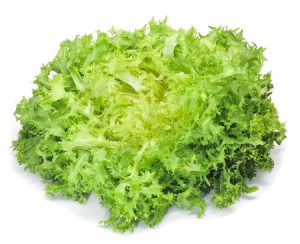- Endive is a fast growing vegetable with a fresh tangy flavour.
- Pick individual leaves as needed or as a whole plant.
- A great source of vitamin A & C
Endive is really a rough type of lettuce which seems rather unfair on a salad crop which offers more potential in cooking. It is often conflated with chicory but it all depends on where you live in Europe. The endive found in plastic wrapping on the grocer’s shelf often looks like a frilly lettuce and many folks have mistakenly bought one without realising they are often more bitter, perhaps more ‘grown-up’. We sometimes grow them in the garden border because they look better and we are short of gardening space at various times.
In taste terms, the endive is crisp leaved. It also has a bitter taste so is best blanched by covering the plant as with chicory to sweeten it up. It usually turns from its green to a stone white which is more attractive. N.B. Blanching here does not mean a rapid cooking!
The endive, rather like the lettuce was first grown around the Mediterranean region because it is discussed in ancient Greek and Roman literature. the majority of the cultivars originate in France, Italy and other countries bordering the Aegean Sea.
Two types are known: curled/curly and frisée. The frisée form flat rosettes of thin, slender and usually significantly indented leaves. The curly resemble a typical lettuce and in some cases there are crosses between them which confuse the picture. None are frost-hardy which means they need to be grown for summer and early autumn seasons.
Broad-leaved endive which are sometimes called Escarole and Batavian are much larger and hardier. They have coarse rough leaves and are not as pretty a plant. These are sown from late autumn through to mid-spring and make up for their lack of attractiveness with a supply of green leaves for cooking. Not only is it and end-of season lettuce replacement, it makes a good winter salad. These plants are hardier than lettuce and do not seem to be damaged by disease or pests as much.

Sowing Outdoors
Sow thinly where they are to crop. The autumn and winter types do not need very fertile soil but they will need an open site and good drainage. Have the soil pH about 5.5 to 7. 5 which is quite a range. Add lime if the soil is peaty.
The summer types are sown in July because the crop will reach maturity 3 months later for picking in October. We also use it as a crop to replace lettuce when it has been ravaged by slugs etc. towards the end of the season.
Sow seeds 1.5cm (1/2″) deep and directly into finely prepared soil which has already been watered. Allow 25cm (10″) between rows. The alternative is to sow into modules and then transplant out. This is better when the weather is really poor or if its cold as in the latter part of the year. It also means the modules can be moved about and protected indoors if needs be.
Germination is poor in hot weather so avoid sowing in the greenhouse from April onwards until early September. We sow for winter and spring harvest in modules and keep in the greenhouse. If its too hot we bring the trays outside. The spring crop is started in October, with seedlings overwintered and then planted out in January or February if the weather is good enough.
When grown outdoors, early sowings benefit from cloche protection. Seedlings appear in 7 to 14 days. Thin out to 20cm (8″) apart and the maximum distance should be 35cm if you know the optimum size of an endive plant. (They are often much larger plants than lettuce).
No thinning is necessary if only baby leaves are needed. Water well until plants are established. Regular sowings made every two to three weeks ensure a continuous supply.
Do not use a hoe as this often damages the plants especially their roots. Just hand weed.
Keep watering going in the dry parts of any season to deter aphids.
Harvesting Endive
Try cutting just a few leaves from each plant especially the broad-leaf varieties. The leaves are ideal for those baby leaf salads.
These plants can survive four cuts otherwise cut the whole heads of the plant. Once cut the leaves do not keep well in the fridge so use as fresh as possible.
The leaves can be blanched to reduce bitterness and the whole process takes about 10 days to manage properly. It’s a common method where the plant is covered with opaque sheeting on a cloche. It’s similar to treatment of chicory in many respects. Photosynthesis is severely reduced so it cannot produce the bitter compounds as effectively. Some gardeners use pots to cover the really flat types. We use a bucket or rhubarb top to cover the really tall types. Make sure the pot or whatever is covering the plant has an air gap underneath to promote air circulation. The last thing anyone needs is rotting. We usually start off when the weather has been dry a few days.
You can find self-blanching types and many endive will also blanch themselves when they are grown so close together.
Pests
Mainly slugs eating the leaves – deal with as you feel fit.
Varieties
Broad-leaved:
- Cornet de Bordeaux
- Scarola Bionda.
Curled:
- Frenzy AGM
- Natacha AGM
- Pancalieri
Products And Seeds
Please note we are affiliate marketing partner. Please read our affiliate disclosure.
Purchase your endive seeds here
Revised: This article first written on 4th November 2016 with new material added.